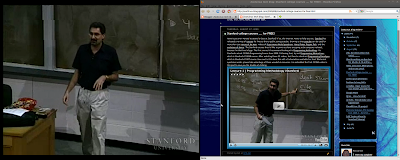In the interests of bandwidth, smaller thumbnails are shown, but larger res versions are available if you click on them. Let’s assume that you have found awesome blog or website on the Internet about Linux stuff with embedded YouTube videos, such as the Pandora Video Vault or, ahem, my blog.
Example number one: You start the video, then attempt to maximize the video to see more. Sadly, instead of filling your whole screen, huge white bars above and below your video appear, and the video plays at the same resolution as before you maximized. Sometimes, the video gets smaller!
Example number two: Your dual screen computer has Firefox open in its secondary display, and you try to maximize your window. Instead of maximizing in the current screen, it takes over the primary display. To add insult to injury, it still has the large white bands above and below the video.
Clicking on your Internet browser in the secondary display immediately causes the video to return to the embedded link in the page. The same thing happens if you click the primary window. You’re pretty much stuck viewing the videos in the resolution in which they are initially presented.
Enter MiniTube, stage left.
MiniTube (currently at version 0.8.1)allows you to overcome some of these restrictions and annoyances. MiniTube opens up as an application and allows you to easily make the videos full screen. It’s available for Linux and Mac OSX. Since it doesn’t use Flash, you may also see performance increases on hardware that doesn’t play well with Flash. 

Since MiniTube is a YouTube video viewer, I should probably include a youtube link to it. Unfortunately, the only link to a current video that I can find is in Italian with a strange Matrix-esque soundtrack. It shows off Minitube well enough, though.
There are still some issues with MiniTube, though. When watching full-screen videos on MiniTube, if you interact with a web browser window in the screen opposite the full-screen video, the menu panels will appear. Most of the time, this is fine, as the video is still large, and I am able to interact with the browser without having any of the aforementioned craziness occur.
Navigation in MiniTube is an issue. The only method that MiniTube appears to use for navigation is a small search window in the upper right hand corner. After entering a search term, you can search for the most relevant, most recent, or most viewed entries. Finding a particular video that’s already been embedded in a web page is not as straightforward as simply clicking it. You typically have to search MiniTube for the explanatory text shown in the embedded window, such as “Pandora mupen64plus” or “Stanford Programming Methodology”. The search function does work quite well, but it’s a little annoying to type something like “Stanford Programming Methodology” over and over again. On the main screen of MiniTube there is a search history, so you don’t necessarily have to retype everything, but move navigating options would be nice. MiniTube doesn’t feature any graphical feedback on how the video is loading. One of the videos I watched started stuttering about halfway through. After pausing the video for about a minute and starting it again, it played just fine, but it would have been nice to know how much buffer remains before I get to the stuttering. This next thing might be either positive or negative depending on what you prefer. MiniTube is designed to be a refactoring of YouTube into a more television-like experience. When you mouseover the full screen, nothing happens. This can be liberating if you are used to YouTube contstantly reminding you about the Escape key allowing you to leave full-screen mode, as well as displaying some rather annoying pop-ups. However, the only navigation you can do from full-screen is “Stop”, “Play”, “Skip”, and “Exit Full Screen”. Once you are back in the windowed MiniTube player, you can skip around in the video using the slider.
Conclusion:
Although MiniTube is not perfect, I will keep using it in order to avoid the full-screen shenanigans that happen with Flash. If Adobe gets their act together and release versions of Flash for Linux that don’t suck, I may change that opinion.










